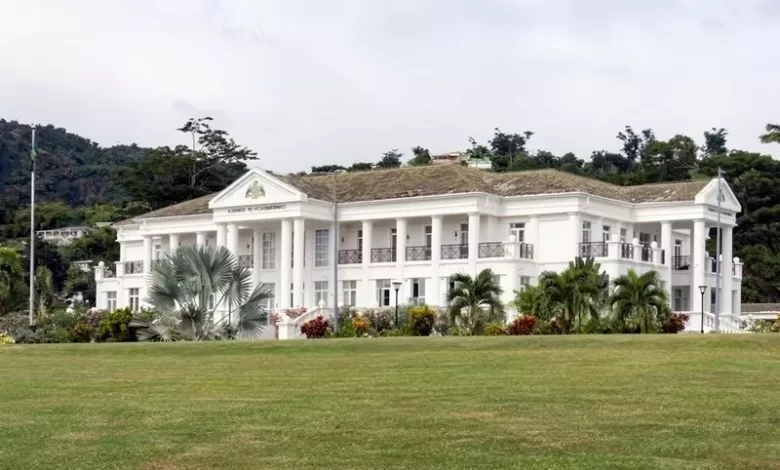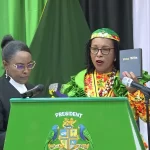Government of Dominica

The Dominica Government operates as a parliamentary democracy within the framework of a republic. Officially known as the Commonwealth of Dominica, the country gained independence from the United Kingdom on November 3, 1978. The Constitution of Dominica defines the government structure, which establishes a separation of powers among the executive, legislative, and judicial branches.
About Dominica Government
Dominica’s Government comprises the executive (President and Prime Minister), legislative (House of Assembly), and judicial branches. It emphasizes sustainable development, regional cooperation, and active political participation.
The executive branch of the Dominica Government consists of the President and the Prime Minister. The President, who serves as the ceremonial head of state, is elected for a five-year term by the House of Assembly. Nominated by the Prime Minister in consultation with the Leader of the Opposition, the President appoints the Prime Minister, who must command a majority in the House of Assembly. The Prime Minister, currently Roosevelt Skerrit, leads the executive government and appoints cabinet ministers from the House of Assembly. The Cabinet is collectively responsible to the parliament and can be removed by a vote of no confidence.
Current Cabinet Members
- Prime Minister and Minister for Investment and Governance: Hon. Roosevelt Skerrit
- Minister for National Security and Legal Affairs: Hon. Rayburn Blackmoore
- Minister for Finance, Economic Development, Climate Resilience and Social Security: Hon. Dr. Irving McIntyre
- Minister for Foreign Affairs, International Business, Trade and Energy: Hon. Dr. Vince Henderson
- Minister for Education, Human Resource Planning, Vocational Training, and National Excellence: Hon. Octavia Alfred
- Minister for Labour, Public Service Reform, Social Partnership, Entrepreneurship and Small Business Development: Hon. Miriam Blanchard
- Minister for Health, Wellness and Social Services: Hon. Cassanni Laville
- Minister for Housing and Urban Development: Hon. Melissa Skerrit
- Minister for Environment, Rural Modernisation, Kalinago Upliftment and Constituency Empowerment: Hon. Cozier Frederick
- Minister for Tourism: Hon. Denise Charles
- Minister for Agriculture, Fisheries, Blue and Green Economy: Hon. Roland Royer
- Minister for Public works, Public Utilities and Digital Economy: Hon. Fidel Grant
- Minister for Culture, Youth, Sports and Community Development: Hon. Gretta Roberts.
- Minister of State in the Ministry of Labour, Public Service Reform, Social Partnership, Entrepreneurship and Small Business Development: Hon. Daren Pinard
- Minister of State in the Ministry of Agriculture, Fisheries, Blue and Green Economy: Hon. Jullan Defoe
- Minister of State in the Ministry of Culture, Youth, Sports and Community Development: Hon. Oscar George
- Minister of State in the Ministry of Public works, Public Utilities and Digital Economy: Hon. Chekira Lockhart-Hypolite
- Minister of State in the Ministry of Health, Wellness and Social Services: Hon. Dr. Cassandra Williams
- Parliamentary Secretary in the Ministry of Education, Human Resource Planning, Vocational Training, and National Excellence: Hon. Fenella Wenham
- Parliamentary Secretary in the Ministry of Environment, Rural Modernisation, Kalinago Upliftment and Constituency Empowerment: Hon. Darron Lloyd
- Parliamentary Secretary in the Ministry of Agriculture, Fisheries, Blue and Green Economy: Hon. LaKeyia Joseph
- Parliamentary Secretary in the Ministry of Health, Wellness and Social Services: Hon. Kent Edwards
Legislative Branch
Dominica’s legislative power is vested in a unicameral parliament called the House of Assembly. The House of Assembly comprises 32 members: 21 elected representatives, 9 senators, and 1 ex-officio member (the Attorney General). Senators are either appointed by the President on the advice of the Prime Minister and the Leader of the Opposition or elected by regional representatives. The members elect the Speaker of the House. Legislative elections occur every five years, although the Prime Minister can call elections anytime. This structure ensures a robust parliamentary system that governs the legislative process.
Constituencies and Representatives
Dominica is divided into 21 constituencies, each represented by an elected Member of Parliament (MP). These constituencies include:
- Castle Bruce
- Colihaut
- Cottage
- Grand Bay
- La Plaine
- Mahaut
- Marigot
- Morne Jaune/Riviere Cyrique
- Paix Bouche
- Petite Savanne
- Portsmouth
- Roseau Central
- Roseau North
- Roseau South
- Saint Joseph
- Salisbury
- Salybia
- Soufriere
- St. Mark
- St. Paul
- Wesley
Each MP represents the interests of their constituency in the House of Assembly and plays a crucial role in shaping national legislation.
Judicial Branch
Dominica’s legal system is based on English common law. The judicial branch is independent of the executive and legislative branches. The highest court in Dominica is the Eastern Caribbean Supreme Court, which includes the High Court of Justice and the Court of Appeal. Appeals can be made to the Caribbean Court of Justice. Dominica’s judicial system ensures the rule of law and provides a mechanism for resolving disputes through an established legal framework.
Local Government
Local government in Dominica is administered through a system of village councils and city councils. Roseau, the capital city, has its city council. These local bodies manage community resources, public health, and regional infrastructure projects. Dominica is divided into ten parishes, each with its own governance structures. These include Saint Andrew, Saint David, Saint George, Saint John, Saint Joseph, Saint Luke, Saint Mark, Saint Patrick, Saint Paul, and Saint Peter.
Political Parties and Elections
Dominica operates a multi-party political system, with the Dominica Labour Party (DLP) and the United Workers Party (UWP) being the major political parties. The political landscape is characterized by active electoral participation, with general elections every five years. The DLP, led by Prime Minister Roosevelt Skerrit, has been the dominant party in recent years, significantly influencing Dominica’s political and economic policies.
Historical Context
Dominica’s journey to independence and its subsequent political development has been shaped by several key figures and events. Patrick John served as the first Prime Minister after independence. Dame Mary Eugenia Charles, the first female Prime Minister in the Americas, played a crucial role in stabilizing the country during her tenure from 1980 to 1995. Her leadership marked a significant period of political and economic reform in Dominica.
International Relations and Organizations
Dominica participates in various international organizations, reflecting its active role in global diplomacy and regional cooperation. These include the Caribbean Community (CARICOM), the Organization of Eastern Caribbean States (OECS), the United Nations (UN), the Commonwealth of Nations, and the Organization of American States (OAS). Dominica’s foreign policy focuses on regional integration, sustainable development, and international cooperation.
Cabinet of Dominica
The Cabinet of Dominica is composed of ministers responsible for various government departments. Key cabinet positions include the Minister for Finance, Minister for Health, Minister for Education, and Minister for Foreign Affairs. The Cabinet, led by the Prime Minister, implements government policies and oversees the administration of public services.
Ministry of National Security and Legal Affairs
The Ministry of National Security plays a vital role in Dominica’s governance. It provides legal advice and representation to the government, administers justice, and ensures public safety. The ministry oversees divisions such as the Chamber of the Attorney General, the Commonwealth of Dominica Police Force, the Immigration Division, and the Office of Disaster Management. These entities work together to uphold the rule of law and protect citizens’ rights.
Government House
Government House, located in Roseau, serves as the official residence of the President of Dominica. This historic building has been the home to Dominica’s heads of state since independence in 1978. It also symbolizes the country’s colonial heritage and transition to a sovereign republic.
List of Prime Ministers of Dominica
Since gaining independence, Dominica has had several prime ministers who have shaped the nation’s political landscape:
- Patrick John (1978–1979)
- Oliver Seraphin (1979–1980)
- Eugenia Charles (1980–1995)
- Edison James (1995–2000)
- Rosie Douglas (2000)
- Pierre Charles (2000–2004)
- Roosevelt Skerrit (2004–present).
Constitution and Legal Framework
The Constitution of Dominica is the supreme law of the land, providing the framework for governance and protecting citizens’ rights and freedoms. It outlines the structure of government, the functions of each branch, and the procedures for enacting laws. The Constitution also guarantees fundamental rights such as freedom of speech, assembly, and religion.
Economic Policies and Development
The Dominica Government has implemented various economic policies to promote sustainable development, improve infrastructure, and enhance the quality of life for its citizens. Key initiatives include investments in renewable energy, tourism, and agriculture. The government also focuses on social welfare programs to support education, healthcare, and housing.
Education and Healthcare
The government prioritizes education and healthcare as essential components of national development. Efforts are made to provide accessible and quality education from primary to tertiary levels. Similarly, healthcare services are continually improved to ensure all citizens access necessary medical care. The Ministry of Education and the Ministry of Health spearhead these initiatives.
Infrastructure and Transportation
Infrastructure development is a critical aspect of Dominica’s economic strategy. Projects include constructing and maintaining roads, bridges, and public buildings. The Edward Oliver Leblanc Highway is a notable infrastructure project that enhances connectivity across the island. Additionally, the government is investing in modernizing ports and airports to support tourism and trade.




